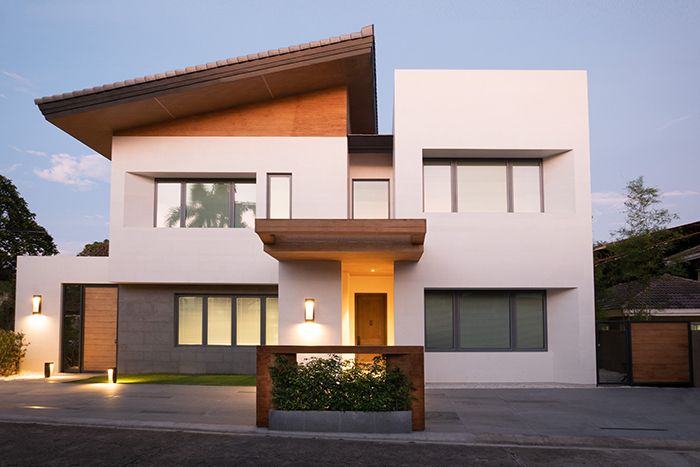What is Minimalist House Design?

Minimalist house design is a design philosophy that emphasizes simplicity, clarity, and functionality. It involves stripping away unnecessary elements and focusing on the essential features of a home. The goal is to create a clean, uncluttered, and peaceful living space that promotes a sense of well-being and harmony. Minimalist homes often feature open floor plans, minimal ornamentation, and a limited color palette.
What is LEED Certification?
LEED (Leadership in Energy and Environmental Design) certification is a recognized standard for measuring the environmental sustainability of buildings. Developed by the U.S. Green Building Council (USGBC), LEED certification is based on a point system that evaluates a building’s performance in several areas, including energy efficiency, water conservation, indoor air quality, and waste reduction. LEED certification is a prestigious recognition that a building has achieved a high level of environmental sustainability.
The Perfect Blend: Minimalist House Design and LEED Certification
Minimalist house design and LEED certification are a perfect blend because they share a common goal: to create a sustainable and energy-efficient living space. Minimalist homes, by their very nature, tend to be more energy-efficient and environmentally friendly. They often require fewer materials, less energy, and less water to build and maintain. LEED certification takes this a step further by providing a framework for measuring and evaluating a building’s environmental sustainability.
Key Features of Minimalist House Design for LEED-Certified Homes
- Open Floor Plans: Open floor plans are a hallmark of minimalist house design. They promote a sense of openness and flow, making the home feel larger and more spacious. Open floor plans also allow for more natural light and ventilation, reducing the need for artificial lighting and heating and cooling.
- Minimal Ornamentation: Minimalist homes often feature minimal ornamentation, such as moldings, trim, and other decorative elements. This not only reduces waste and minimizes the use of materials but also creates a clean and uncluttered living space.
- Sustainable Materials: Minimalist homes often incorporate sustainable materials, such as reclaimed wood, bamboo, and low-VOC paints. These materials are not only eco-friendly but also durable and long-lasting.
- Energy-Efficient Systems: LEED-certified homes require energy-efficient systems, such as solar panels, rainwater harvesting systems, and high-efficiency HVAC systems. Minimalist homes can incorporate these systems seamlessly, reducing energy consumption and greenhouse gas emissions.
- Natural Lighting: Natural lighting is a key feature of minimalist house design. Large windows, skylights, and solar tubes bring in natural light, reducing the need for artificial lighting and creating a sense of warmth and coziness.
Benefits of Minimalist House Design for LEED-Certified Homes
- Energy Efficiency: Minimalist homes are often more energy-efficient, requiring less energy to heat, cool, and power.
- Water Conservation: Minimalist homes can incorporate water-conserving features, such as low-flow showerheads and toilets, reducing water consumption and waste.
- Improved Indoor Air Quality: Minimalist homes often feature natural ventilation, reducing the need for air conditioning and heating and improving indoor air quality.
- Reduced Waste: Minimalist homes require fewer materials and generate less waste, reducing the environmental impact of construction and maintenance.
- Increased Property Value: LEED-certified homes, including those with minimalist design, can increase property value and appeal to environmentally conscious buyers.
Challenges and Limitations
While minimalist house design and LEED certification can be a perfect blend, there are challenges and limitations to consider. Some of these include:
- Higher Upfront Costs: LEED certification and sustainable materials can increase upfront costs, making it more challenging for homeowners to afford.
- Limited Design Options: Minimalist design can be limiting, with fewer options for decorative elements and finishes.
- Balancing Form and Function: Achieving a balance between form and function can be challenging, particularly in small or compact spaces.
Frequently Asked Questions (FAQs)
- What is the cost of LEED certification?
The cost of LEED certification varies depending on the size and complexity of the project. On average, LEED certification can cost between $1,000 and $10,000 or more. - Can I achieve LEED certification without a professional architect or builder?
While it’s possible to achieve LEED certification without a professional architect or builder, it’s highly recommended to work with experienced professionals to ensure compliance with LEED standards and requirements. - What are the benefits of minimalist house design?
The benefits of minimalist house design include reduced energy consumption, lower maintenance costs, and improved indoor air quality, among others. - Can I incorporate decorative elements in a minimalist home?
Yes, decorative elements can be incorporated in a minimalist home, but they should be minimal and thoughtfully chosen to avoid clutter and visual distraction. - How long does it take to achieve LEED certification?
The time it takes to achieve LEED certification varies depending on the complexity of the project and the level of certification sought. On average, it can take several months to a year or more to complete the certification process.
Conclusion
Minimalist house design and LEED certification are a perfect blend for homeowners seeking to create a sustainable, energy-efficient, and beautiful living space. By incorporating key features such as open floor plans, minimal ornamentation, and sustainable materials, homeowners can achieve a high level of environmental sustainability while promoting a sense of well-being and harmony. While there are challenges and limitations to consider, the benefits of minimalist house design and LEED certification far outweigh the costs. As the demand for eco-friendly and sustainable homes continues to grow, minimalist house design and LEED certification will remain a popular choice for homeowners seeking to create a better future for themselves and the environment.
Closure
Thus, we hope this article has provided valuable insights into Minimalist house design for LEED-certified homes. We appreciate your attention to our article. See you in our next article!